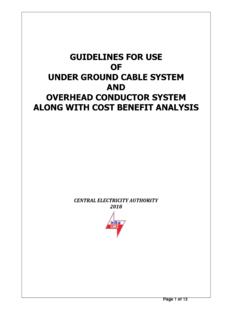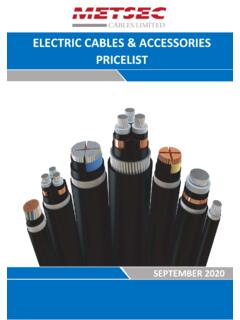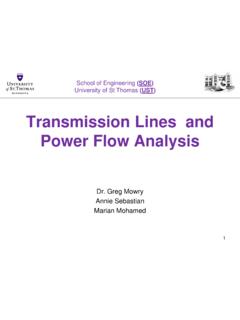Transcription of Transmission Line General Requirements Including Typical ...
1 Transmission Line General Requirements Including Typical Overhead Line Structures Document Number: 1-03-FR-09 VERSION June 2018 This functional Requirements document is in line with the organisation's 1-03-ACS-01 Transmission Line Conductors, 1-03-ACS-02 Transmission Line Insulators, 1-03-ACS-03 Transmission Line Earthing, 1-03-ACS-04 Pole Structures and Foundations, 1-03-ACS-05 Lattice Structures and Foundations Asset Class Strategies. Intellectual property rights and disclaimer This document is published in accordance with the Requirements of Chapter 5 of the National Electricity Rules (NER). It is a functional requirement document only and is not intended to contain any comprehensive or project specific designs, specifications or other information.
2 Whilst care has been taken to ensure that the contents of this document are accurate, ElectraNet Pty Limited (ElectraNet) does not represent or warrant that the information contained in this document is complete, accurate or adequate in any respect. ElectraNet reserves the right to amend this document at any time without notice to any person. The user must carefully examine and check the information contained in this document and carry out its own independent technical and legal assessment and due diligence to ensure that the information in this document is used appropriately and that in doing so, all Requirements ( Including Requirements at law) are satisfied.
3 For the avoidance of any doubt, the publication of this document does not limit or detract from the user s obligations at law, and does not and will not give rise to any claim ( Including , without limitation, in contract, tort, equity, under statute or otherwise) against ElectraNet or any of its Associates (as that term is defined in Corporations Act 2001 (Cth)). All intellectual property rights ( Including without limitation any copyright, patents, logos, designs, circuit layouts, trademarks, moral rights and know how) in the whole and every part of this document are owned by or licenced to ElectraNet. Except as expressly provided in Chapter 5 of the NER or with the prior written consent of ElectraNet, the contents of this document cannot be used, transferred, copied, modified or reproduced in whole or in part in any manner or form or in any media.
4 ElectraNet Pty Limited. All rights reserveTransmission Line General Requirements Including Typical Overhead Line Structures l Document No: 1-03-FR-09 Security Classification: Public WHEN PRINTED THIS DOCUMENT IS UNCONTROLLED Date: June 2018 Version: ElectraNet Pty Limited 2018 all rights reserved Page 3 of 17 Contents 1. Definitions .. 4 2. Purpose .. 5 3. Introduction .. 5 4. Transmission Lines Components .. 6 Transmission Line Structures .. 6 Transmission Line Conductors .. 6 Transmission Line Insulators .. 7 Transmission Line Earthing .. 7 Appendix A System Boundaries .. 10 A1 General System Boundary ..10 A2 Structure Insulator and Earthing System Boundary.
5 11 A3 Structure / Foundation System Boundary ..12 Appendix B Transmission Lines Functional Locations .. 13 Appendix C Typical Overhead Structures .. 16 Transmission Line General Requirements Including Typical Overhead Line Structures l Document No: 1-03-FR-09 Security Classification: Public WHEN PRINTED THIS DOCUMENT IS UNCONTROLLED Date: June 2018 Version: ElectraNet Pty Limited 2018 all rights reserved Page 4 of 17 1. Definitions In this document the following words and expressions will have the following meanings: Item Meaning AAAC All aluminium Alloy conductor AAC All aluminium conductor AC aluminium Cladding acsr aluminium conductor Steel Reinforced Grazer Visual information system used by ElectraNet GZ Galvanised kV Kilo-Volt NER National Electricity Rules OPGW Optical Ground Wire (earth cable that contains optical fibres used for telecommunications) PG Parallel Groove PVC Polyvinyl Chloride SC Steel conductor Transmission Line General Requirements Including Typical Overhead Line Structures l Document No: 1-03-FR-09 Security Classification.
6 Public WHEN PRINTED THIS DOCUMENT IS UNCONTROLLED Date: June 2018 Version: ElectraNet Pty Limited 2018 all rights reserved Page 5 of 17 2. Purpose The purpose of this document is to provide a high level summary of the various components which make up ElectraNet s Transmission Lines. Primary and secondary functions of Transmission line components are provided for context. 3. Introduction The term Transmission Lines broadly refers to overhead Transmission lines and underground cables. The key function of a Transmission line is to transfer bulk power between generation sources and load centres. ElectraNet owns, manages and operates Transmission lines at 275kV, 132kV and 66kV.
7 Transmission Lines are made up of various components, namely poles, lattice structures, conductors, cables, insulators, foundations and earthing systems. These components are described in more detail in this document. Minimum Clearance RequirementsConductor Rating LimitsMax Tension LimitsEMI and Noise LimitsMarker BallFull tension jointVibration damperSpacerWind/ Solar RadiationSuspension clampStrain clamp Figure 3-1: Typical Transmission Line Transmission Line General Requirements Including Typical Overhead Line Structures l Document No: 1-03-FR-09 Security Classification: Public WHEN PRINTED THIS DOCUMENT IS UNCONTROLLED Date: June 2018 Version: ElectraNet Pty Limited 2018 all rights reserved Page 6 of 17 4.
8 Transmission Lines Components Transmission Line Structures The primary functions of Transmission line structures are to provide mechanical support to conductors. This is achieved by maintaining mechanical integrity without permanent structural deformation under ultimate load conditions whilst preserving structure geometry to retain operational electrical clearances under prescribed serviceability and ultimate load conditions. Secondary functions of Transmission line structures are to: a) Ensure safety of people and the environment; b) Maintain structure geometry to preserve maintenance-safe approach distances for serviceability and ultimate load conditions; c) Provide an electrical path to earth for fault currents; and d) Provide a whole-of-life cost-effective service.
9 Structure types include free-standing and guyed: a) Lattice towers / masts; b) Steel tubular poles; c) Stobie poles; and d) Concrete poles. Refer to Appendix C for a diagram of Typical overhead Transmission line structures. Typical foundations of Transmission line structures are: a) Bored piers; b) Mass concrete; c) Driven / cast in-situ piles; d) Soil / rock anchors; and e) Special Foundations ( raft foundations). Transmission Line Conductors The primary function of Transmission line conductor systems is to transfer electrical power between designated locations, within prescribed performance, operating and environmental conditions. Secondary functions of Transmission line conductors are to: a) Maintain electrical safety and minimise adverse effects on the environment; and b) Provide a whole-of-life cost-effective service.
10 Transmission Line General Requirements Including Typical Overhead Line Structures l Document No: 1-03-FR-09 Security Classification: Public WHEN PRINTED THIS DOCUMENT IS UNCONTROLLED Date: June 2018 Version: ElectraNet Pty Limited 2018 all rights reserved Page 7 of 17 Transmission Line Insulators Transmission line insulation has two primary functions: a) To insulate energised components from earthed structures at rated operating voltages and specified switching and lightning impulses; and b) To support the conductor system up to ultimate mechanical load limits and transfer the mechanical loads to structure. Transmission line hardware has four primary functions: a) To support the Insulator system up to electrical load limits; b) To support the Insulator system up to ultimate mechanical load limits; c) To provide effective attachment interface between conductor and Insulators to securely transfer loads to the structure; and d) To provide a whole-of-life cost effective service.




